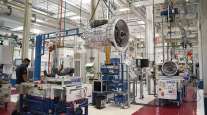Factories Expand at Slowest Rate in a Year

U.S. factories expanded at the weakest pace in a year in January as orders cooled, a sign weakness in overseas markets is restraining U.S. manufacturing, the Institute for Supply Management said.
ISM’s monthly factory index dropped to 53.5 from 55.1 in December, the Tempe, Arizona-based group reported Feb. 2. Readings greater than 50 signal growth, and the median forecast in a Bloomberg News survey of economists called for a decline to 54.5.
Plunging oil prices is limiting sales at some manufacturers, while slower growth from Europe to China and the strengthening dollar represent another hurdle for American exports. At the same time, consumer spending that’s coming off the best quarterly gain since 2006 indicates U.S. production will probably hold up.
“What we’re seeing is a moderation rather than any major deterioration,” said Gennadiy Goldberg, U.S. strategist at TD Securities USA in New York. “The weak global backdrop along with the stronger dollar is not very positive for U.S. exporters. We still have very strong domestic demand, which is a big positive.”
ISM’s gauge of new orders fell to 52.9 in January, also the weakest reading in a year, from 57.8 at the end of 2014. The index has dropped about 10 points since October.
Export orders fell to 49.5 in January from 52.5, the first time since November 2012 that demand from overseas customers shrank. Order backlogs were the weakest since July 2013. ISM’s employment measure fell to 54.1 in January from 56, while the group’s production gauge eased to 56.5 from 57.7 in December.
A gauge of factory inventories rose to 51 in January from 45.5 a month earlier and an index of customer stockpiles fell to 42.5 from 44.5. The report also showed the index of prices paid deteriorated to 35, the lowest since April 2009, from 38.5.
The U.S. expansion is being driven by growth in household purchases. Consumer spending, which accounts for almost 70% of the economy, grew in the fourth quarter at a 4.3% annualized pace, the most since 2006, Commerce Department data showed late last month, while the U.S. economy advanced at a 2.6% rate.
“Economic activity has been expanding at a solid pace,” the Federal Reserve said in a Jan. 28 statement, as it maintained its pledge to be “patient” on raising interest rates.
“Labor market conditions have improved further, with strong job gains and a lower unemployment rate,” the Fed said.




